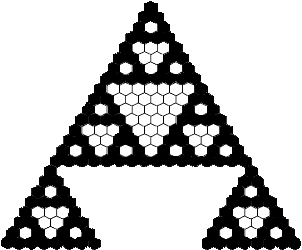
When all the odd numbers in Pascal's
Triangle are filled in and the rest are left
blank, the recursive Sierpinski Triangle
fractal is revealed.
| Fractals - Tutorials |
 When all the odd numbers in Pascal's Triangle are filled in and the rest are left blank, the recursive Sierpinski Triangle fractal is revealed. |
| What is a
fractal? Here are some very simple introductions [ 1
| 2
| 3
| 4
]. From the Butterfly Effect to fractals: here's an explanation showing how they are related. The discoverer of fractals, mathematician Benoit Mandelbrot, wrote a non-technical explanations explaining what fractal geometry is and what it can be used for. Wikibooks has a succinct summary of the necessary requirements for a fractal. Fractals are defined by, among other things, their dimensionality. They have a dimension that is less than their Euclidean dimension (in other words, the number of dimensions that are needed to contain their graph), but greater than their Hausdorff dimension. This article, though a little long, is a simple introduction to several ideas: dimensionality, self-similarity, and the Cantor Set. The Cantor Set is considered to be the simplest fractal to be found. Understanding this set will make it much easier to understand how more complex fractals are constructed. With a little background, these Wiki pages [ 1 | 2 | 3 | 4 ] will make sense. Naturally, Yale University--the academic home of Mandelbrot--has an extensive web site on fractals. Fractals Unleashed is a comprehensive site that includes a tutorial, a list of the types and applications of fractals. Plus, of course, there's the usual stunning images in the gallery. |
| Home
|
Overview
|
History
|
Tutorials
|
Multimedia
and
Lectures Examples and Simulations | Advanced Topics |